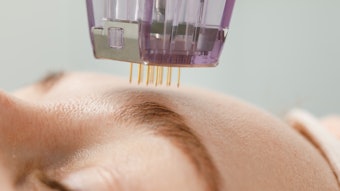
A May 2024 study published in the Immunity journal found that an activated protein within a certain biological pathway causes inflammation in skin suffering from psoriasis. The promising discovery can lead to improved therapies for inflammatory skin diseases.
The experiment analyzed results from mice and human skin tissue samples from people with psoriasis. Researchers at NYU Langone Health found that the interleukin-17 (IL-17) pathway, whose activity is blocked by existing anti-inflammatory drugs, activates a protein called hypoxia-inducible factor 1-alpha (HIF-1-alpha) in psoriasis. Researchers say that IL-17 has long been known to be active in inflammation, but the role of HIF-1-alpha has until now been unclear.
The research team also found that HIF-1-alpha lets inflamed skin cells more actively break down sugar for energy, supporting their metabolism and producing a waste product called lactate. When consumed by inflammatory T cells, lactate triggers the production of IL-17, fueling even more inflammation.
Related: Amytrx Publishes Abstract Supporting AMTX-1000 to Treat Mild to Moderate Atopic Dermatitis
Genetic Analysis of Skin Tissue
The study confirms that in human skin tissue samples from people with psoriasis, measures of gene activity around IL-17 and HIF-1-alpha were similar, suggesting that these factors are interconnected. Experiments in mice treated to develop psoriasis found that subsequent treatment with an experimental drug that blocks the action of HIF-1-alpha, called BAY-87-2243, resolved inflammatory skin lesions.
Skin samples from 10 patients successfully treated with the anti-inflammatory drug etanercept showed diminished activity for both IL-17 and HIF-1-alpha, suggesting to researchers that when IL-17 is blocked, so is HIF-1-alpha.
Further experiments were performed on skin samples from five patients with psoriasis whose healthy and inflamed skin was separately treated with either BAY-87-2243 or an existing combination of topical drugs (calcipotriene and betamethasone dipropionate). Researchers then compared differences in inflammatory gene activity as a measure of impact and found that the HIF-1-alpha inhibitor had a greater effect than existing topical drugs. Specifically, skin samples that responded to HIF-1-alpha therapy had 2,698 genes expressed differently, while standard-of-care-treated samples had 147 differently expressed genes.
Genetic analysis of skin samples from another 24 psoriatic patients treated with the IL-17A–blocking drug secukinumab showed only decreased, not heightened, gene activity connected to HIF-1-alpha when compared to HIF-1-alpha gene activity in nine healthy patients with no psoriatic disease. Researchers say this indicates that HIF-1-alpha's blocked action was codependent on the blockage of IL-17.
Additional Findings
Additional experiments in mice showed that blocking sugar (glucose) uptake in the skin slowed psoriatic disease growth by limiting glucose metabolism or glycolysis. Both the number of immune T cells tied to inflammation and the cell levels of IL-17 also decreased. The researchers found further that levels of lactate, the main byproduct of glycolysis, in psoriatic skin cell cultures dropped once exposed to the glycolysis-inhibiting drug 2-DG.
Directly targeting lactate production in psoriatic mice using a topical skin cream containing lactate dehydrogenase, which breaks down lactate, also slowed disease progression in the skin, with reduced numbers of inflammatory gamma-delta T cells and reduced IL-17 activity. Gamma-delta T cells were shown to take up lactate and use it to produce IL-17, per the study.
"Our study results broadly show that activation of HIF-1-alpha is at the crux of metabolic dysfunction observed in psoriasis and that its action is triggered by IL-17, another key inflammatory-signaling molecule," said corresponding study author Shruti Naik, Ph.D., associate professor at NYU Grossman School of Medicine in the Departments of Pathology and Medicine and the Ronald O. Perelman Department of Dermatology. "Our findings suggest that blocking either HIF-1-alpha's action or its glycolytic metabolic support mechanisms could be effective therapies for curbing the inflammation."
"Evidence of HIF-1-alpha's depressed action, or downregulation, could also serve as a biomarker, or molecular sign, that other anti-inflammatory therapies are working," said study co-senior investigator Jose U. Scher, M.D., the Steere Abramson Associate Professor of Medicine in the Department of Medicine at NYU Grossman School of Medicine.











